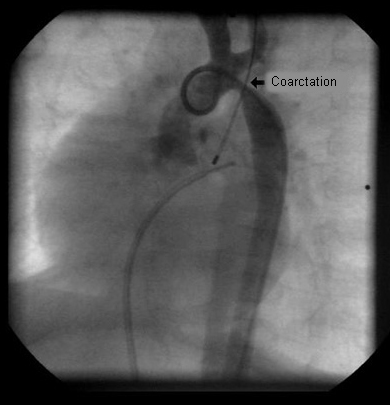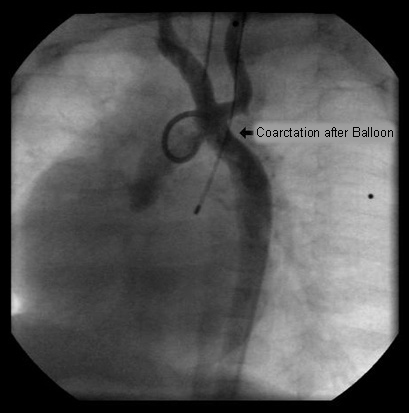Complications
More common in patients who have delayed repair of their coarctation, most likely due to persistent hypertension.[49]
Many patients with coarctation of the aorta will have some degree of residual narrowing of the aortic arch. A significant gradient, particularly with exercise, may be seen.
Gradients >20 mmHg are felt to be indications for intervention.
Persistent hypertension can occur even in patients without residual coarctation.[48]
May occur after either surgical or transcatheter repairs due to scar formation at the site of intervention.
Most of these recoarctations may be managed with balloon angioplasty.[Figure caption and citation for the preceding image starts]: Aortic angiography in an infant after surgical reconstruction of the aortic arch shows marked narrowing at the distal aspect of the surgical repairFrom the personal collection of Jeffrey Gossett, MD, Children's Memorial Hospital, Northwestern University, Chicago; used with permission [Citation ends]. [Figure caption and citation for the preceding image starts]: Balloon angioplasty of the narrowed region leads to complete resolution of the obstructionFrom the personal collection of Jeffrey Gossett, MD, Children's Memorial Hospital, Northwestern University, Chicago; used with permission [Citation ends].
[Figure caption and citation for the preceding image starts]: Balloon angioplasty of the narrowed region leads to complete resolution of the obstructionFrom the personal collection of Jeffrey Gossett, MD, Children's Memorial Hospital, Northwestern University, Chicago; used with permission [Citation ends].
The challenges associated with living with congenital heart disease can lead to depression and anxiety in as many as half of patients. Early-life stressors such as time in intensive care units and other traumatic healthcare experiences can also have a significant impact.[50]
Psychological care should be a routine part of congenital heart disease care, with access given to psychotherapy and pharmacotherapy where needed.[50]
May occur at the site of either surgical or transcatheter interventions. Additionally, may be related to underlying pathology of the vessel or an associated bicuspid aortic valve. If an aneurysm is suspected and is shown to be enlarging, surgical resection is typically required. An alternative is placement of a covered stent over the aneurysmal area.[47]
Use of this content is subject to our disclaimer